|
Battle of Forts Clark and Hatteras
North Carolina Coast and the Civil War
Battle of Hatteras Inlet Batteries
Other Names: Forts Clark and Hatteras
Location: Dare County
Campaign: Blockade of the Carolina Coast (August-December 1861)
Date(s): August 28-29, 1861
Principal Commanders: Maj. Gen. Benjamin F. Butler [US]; Col.
William F. Martin [CS]
Forces Engaged: 9th and 20th New York regiments (est. 2,000)
[US]; Hatteras Island Garrison (900) [CS]
Estimated Casualties: 718 total (US 3; CS 715)*
Result(s): Union victory
Description: The blockade of the North Carolina coast, which included
the Battle of Hatteras Inlet, was a strategic objective in Gen. Winfield Scott's Anaconda Plan. On August 26, an amphibious expedition led by Maj. Gen. Benjamin Butler and Flag-Officer Silas Stringham, embarked
from Fort Monroe to capture Hatteras Inlet, an important haven for blockade-runners. On the 28th, while the navy bombarded
Forts Clark and Hatteras, Union troops came ashore and attacked the rear of the Confederate batteries. On August 29, Col.
William F. Martin surrendered the Confederate garrison of 670. The Federals lost only one man. Butler next returned to Fort
Monroe, leaving the captured forts garrisoned. This movement was part of Union efforts to seize coastal enclaves from which
to enforce the blockade. During
World War II, because of the numerous allied ships sunk by German U-boats, the waters off Cape Hatteras became known
as Torpedo Alley.
| Battle of Hatteras Inlet Map |
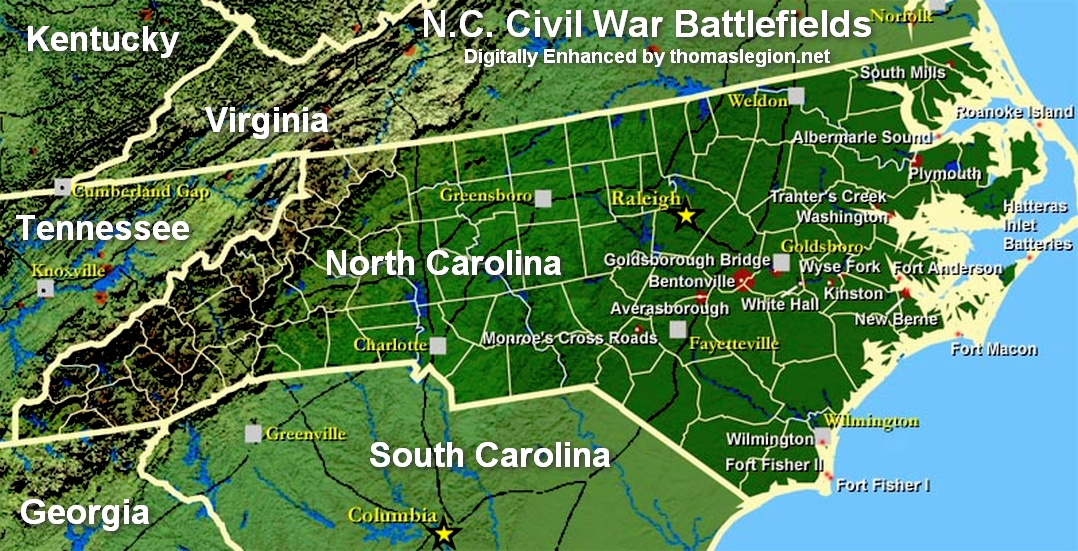
|
| Civil War Battle of Hatteras Inlet Batteries |
| Cape Hatteras and the Civil War |
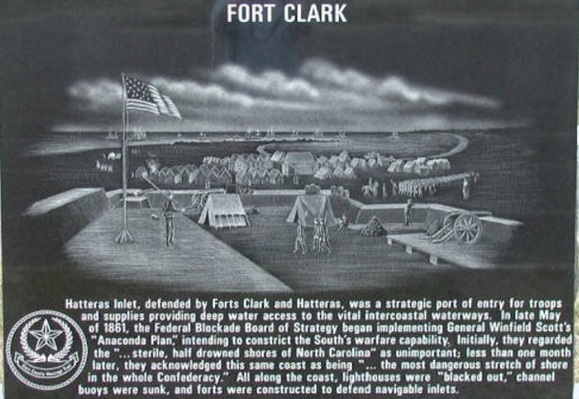
|
| Battle of Fort Clark |
| Civil War Battle of Hatteras Inlet |
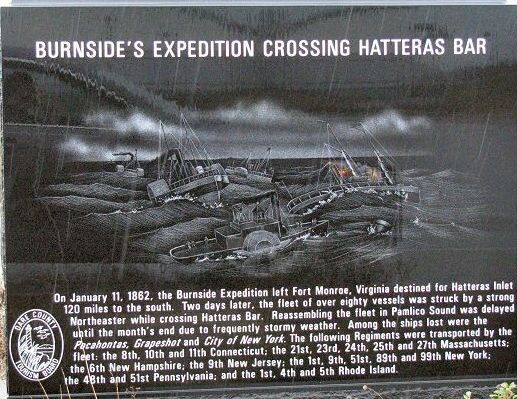
|
| Hatteras Inlet Civil War History |
History:
The Battle of Hatteras Inlet Batteries, part of the Union Navy's Blockade of the Carolina Coast from August to December 1861, was the initial Union sea and land assault against the North Carolina coast.
The Federal Blockade was followed-up with Burnside's North Carolina Expedition from February to June 1862. The Outer Banks of the Tar Heel State would become the setting for important engagements
during the four year Civil War. Union victories at Hatteras Inlet and Roanoke Island early in the war placed the area under Federal control and extended their blockade of the Southern coast. Next, the
Union army would push inland and attack and lay waste to railroads, depots, bridges, mills, and related infrastructure.
The Federal campaign began on August 27, 1861, with an amphibious assault
by Commodore Silas Stringham and General Benjamin Butler on two small and lightly defended forts at Cape Hatteras. The Confederate
government had placed a higher priority on the conflicts in Virginia, and thus had made little effort to outfit and maintain
these forts. The poorly-trained and ill-equipped Confederate militia and recruits manning them were also plagued by the lack
of drinking water and an abundance of mosquitoes. With only a single Union soldier killed, the Federals took forts
Clark and Hatteras in less than 48 hours. The entire Pamlico Sound north to Roanoke Island was now open to Union activity, and for the Confederates the great highway linking coastal
shipping to the rivers of interior North Carolina was beginning to close.
A few months later, the Federals assembled another fleet, this time for an
attack on Roanoke Island. Since the fall of the Hatteras forts, the Richmond government had done little to strengthen the
defense of Roanoke Island. There were three small earthen forts on the island, with a fourth position west of the island across
Croatan Sound (north of the current Manns Harbor Bridge). Because the Confederate general staff was expecting a Union attack
from the north, most of their artillery pieces were fixed in that direction and could not be turned to face an assault from
Pamlico Sound in the south. Due to the Confederate government's commitment to the defense of Richmond, only 1400 soldiers
were made available to hold the strategically important island.
| The Battle of Hatteras Inlet Batteries |
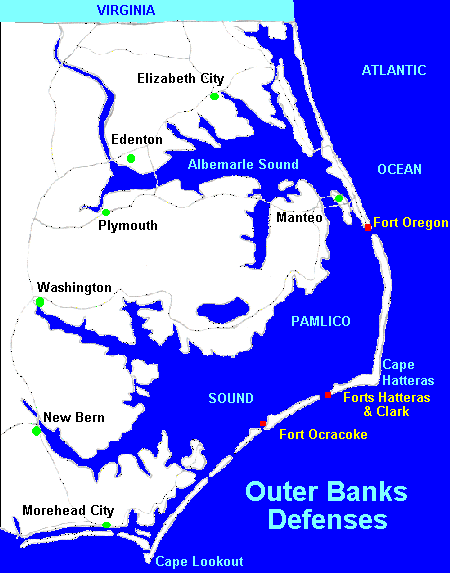
|
| Outer Banks and Fort Hatteras. Courtesy Microsoft TerraServer |
| Battle of Hatteras Inlet History |

|
| Battle of Hatteras Inlet Facts |
1Update to the Civil War Sites Advisory
Commission Report.
After struggling south from Annapolis, Maryland, through a series of winter
storms, Union Maj. Gen. Ambrose Burnside led a fleet of 67 ships and 13,000 men through Hatteras Inlet and then dropped anchor
off the western shore of Roanoke Island on February 5, 1862. He landed 4000 soldiers at Ashby Harbor and after slogging through
the swamps assaulted the Confederate makeshift position near today's intersection of U.S. 64 and N.C. 345. On Croatan Sound,
the South's five-vessel "Mosquito Fleet" harried the Union ships as best it could, but it was badly battered and quickly driven
north out of range.
The island's inexperienced defenders fought tenaciously behind their earthen fortifications
but were eventually outflanked and overwhelmed by Burnside's veterans. Few on either side were killed, and the Union forces
eventually captured the entire Southern defense contingent.
The "Mosquito Fleet" temporarily escaped to
the north, but was destroyed a few days later in a battle near Elizabeth City. The Federals now controlled North Carolina's sounds and access to the state's interior shipping routes. It was a
devastating loss. The Union campaigns on the Outer Banks helped accomplish President Lincoln's goal of a blockade
of the Confederacy's coastline, and helped foster cooperation and coordination between the Union Army and Navy. Today, only
one of the Confederate defensive sites is accessible to visitors. Remnants of the ramparts near the U.S. 64-N.C. 345 intersection
can be seen and parking is available about 100 yards south of the intersection. The
three island forts, either worn down over the years or washed away into Croatan Sound, are commemorated by historic plaques
and street names throughout Roanoke Island.
| Battle of Hatteras Inlet Forts : The Batteries |
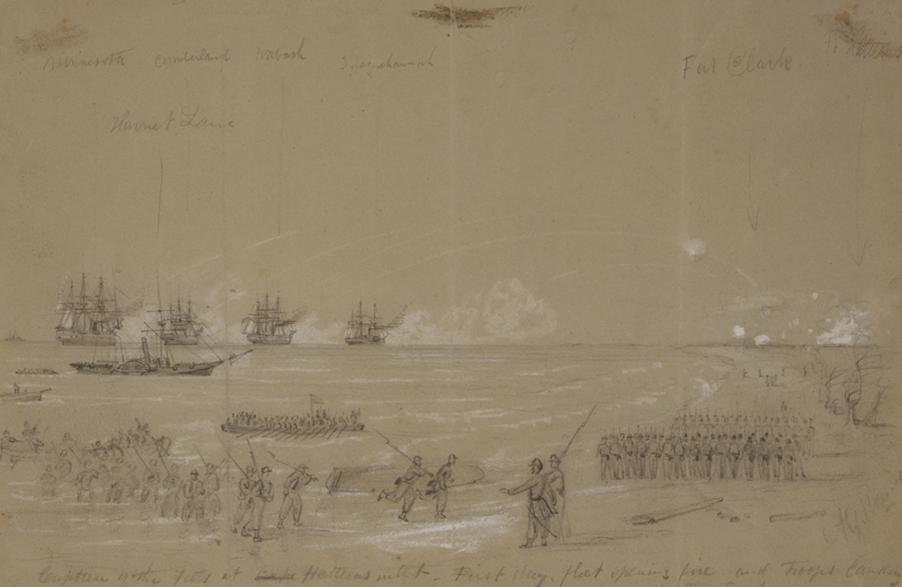
|
| Capture of the Forts at Cape Hatteras Inlet, August 28, 1861. Artist Alfred R. Waud. |
Aftermath: Butler and Stringham left immediately after
the battle, the former to Washington and the latter accompanying the prisoners to New York. Critics argued that each was trying
to gather credit for the victory to himself. The pair contended, however, that they were trying to persuade the administration
to abandon the original plan to block up Hatteras Inlet. In Federal hands it was no longer useful to the Confederacy, and
in fact now allowed Union forces to pursue raiders into the sounds. Although they and their supporters continued to press
the case for several weeks, it seems to have been unnecessary. The War and Navy Departments had already decided to retain
possession of the inlet, which would be used as the entry point of an amphibious expedition against the North Carolina mainland
early the next year. This campaign, known as Burnside's North Carolina Expedition for its senior Army commander Ambrose E.
Burnside, completely removed the sounds as sources of commerce-raiding activity.
Continued Federal possession of Hatteras Inlet was considerably aided
by the Confederate authorities, who early decided that the Ocracoke and Oregon batteries
were indefensible, so they were abandoned. Stringham's tactic of keeping
his ships in motion while bombarding forts was used later by Flag Officer Samuel Francis Du Pont at Port Royal, South Carolina.
The effectiveness of the practice led to a reconsideration of the value of fixed forts against naval gunnery.
*Depending on the source, casualty figures vary slightly.
(Sources and related reading below.)
Recommended Reading: The Civil War
on the Outer Banks: A History of the Late Rebellion Along the Coast of North Carolina from Carteret to Currituck With Comments
on Prewar Conditions and an Account of (251 pages). Description: The ports at Beaufort, Wilmington, New Bern and Ocracoke, part of the Outer Banks (a chain of barrier
islands that sweeps down the North Carolina coast from the Virginia Capes to Oregon Inlet), were strategically vital
for the import of war materiel and the export of cash producing crops. Continued below...
Includes battle accounts of each North Carolina coastal fort and battery.
From official records, contemporary newspaper accounts, personal journals of the soldiers, and many unpublished manuscripts
and memoirs, this is a full accounting of the Civil War along the North Carolina coast.
Recommended Reading: Portrait of the Past : The Civil War on Hatteras Island North Carolina
(Portrait of the Past) (Hardcover). Description: Hatteras Island has achieved a well-deserved reputation as a summer getaway
and a wildlife refuge on North Carolina's coast. However,
most visitors are unaware of the crucial role that Hatteras played in the Civil War. The book offers a new view of Hatteras's
history, interweaving historical facts, archival drawings, and current photography of how the island looks today. In addition,
the book reveals the largely unknown journals of Edwin Graves Champney, a Union soldier who was stationed on Hatteras from
1862 to 1863. Continued below…
Champney's prose and artistic
talents, along with the quotes of soldier Charles F. Johnson of the Ninth New York, shed new light on the experiences of Civil
War soldiers stationed on the Outer Banks during that time. It follows the crucial maritime battles along the Outer Banks
and the famous Burnside Expedition. This is a fascinating history of how one of America's most treasured islands played
a significant part in the Civil War and is a must for any reader. About
the Author: Author: Drew Pullen is a graduate of Houghton College and a former history teacher. He currently manages the Hatteras and Ocracoke
offices of the East Carolina Bank. As an amateur historian, he has written several articles on the Civil War for local newspapers.
His wife Jo Anne is from a local Hatteras family and her great-great grandfather was stationed at Fort Hatteras during the Civil War. Drew continues
to research Civil War action in eastern North Carolina for
future books.
Recommended Reading: The Civil War in Coastal North Carolina
(175 pages) (North Carolina Division of Archives and History). Description: From the drama of blockade-running to graphic descriptions of battles on the state's islands and sounds,
this book portrays the explosive events that took place in North Carolina's coastal region during the Civil War.
Topics discussed include the strategic importance of coastal North Carolina,
Federal occupation of coastal areas, blockade-running, and the impact of war on civilians along the Tar Heel coast.
Recommended Reading:
American Civil War Fortifications (1): Coastal brick and stone forts
(Fortress). Description: The 50 years before the American Civil War saw a boom in the construction of coastal forts in the
United States of America. These stone
and brick forts stretched from New England to the Florida Keys, and as far as the Mississippi River.
At the start of the war some were located in the secessionist states, and many fell into Confederate hands. Although a handful
of key sites remained in Union hands throughout the war, the remainder had to be won back through bombardment or assault.
This book examines the design, construction and operational history of those fortifications, such as Fort
Sumter, Fort Morgan
and Fort Pulaski,
which played a crucial part in the course of the Civil War.
Recommended Reading: Ironclads and Columbiads: The Coast
(The Civil War in North Carolina) (456 pages). Description: Ironclads and Columbiads covers some of the most
important battles and campaigns in the state. In January 1862, Union forces began in earnest to occupy crucial points on the
North Carolina coast. Within six months, Union army and
naval forces effectively controlled coastal North Carolina from the Virginia
line south to present-day Morehead City.
Union setbacks in Virginia, however, led to the withdrawal of many federal soldiers from North Carolina, leaving only enough
Union troops to hold a few coastal strongholds—the vital ports and railroad junctions. The South during the Civil War,
moreover, hotly contested the North’s ability to maintain its grip on these key coastal strongholds.
Recommended Reading: Storm
over Carolina: The Confederate Navy's Struggle for Eastern North Carolina. Description: The struggle for control of the eastern
waters of North Carolina during the War Between the States
was a bitter, painful, and sometimes humiliating one for the Confederate navy. No better example exists of the classic adage,
"Too little, too late." Burdened by the lack of adequate warships, construction facilities, and even ammunition, the
South's naval arm fought bravely and even recklessly to stem the tide of the Federal invasion of North
Carolina from the raging Atlantic. Storm
Over Carolina is the account of the Southern navy's struggle in North
Carolina waters and it is a saga of crushing defeats interspersed with moments of brilliant and even
spectacular victories. It is also the story of dogged Southern determination and incredible perseverance in the face
of overwhelming odds. Continued below...
For most of
the Civil War, the navigable portions of the Roanoke, Tar, Neuse, Chowan, and Pasquotank rivers were
occupied by Federal forces. The Albemarle and Pamlico sounds, as well as most of the coastal towns and counties, were also
under Union control. With the building of the river ironclads, the Confederate navy at last could strike a telling blow against
the invaders, but they were slowly overtaken by events elsewhere. With the war grinding to a close, the last Confederate vessel
in North Carolina waters was destroyed. William T. Sherman
was approaching from the south, Wilmington was lost, and the
Confederacy reeled as if from a mortal blow. For the Confederate navy, and even more so for the besieged citizens of eastern
North Carolina, these were stormy days indeed. Storm Over Carolina describes their story, their struggle, their history.
Recommended Reading: Seacoast Fortifications of the United States:
An Introductory History. Reader’s Review: In the thirty years since this book was published, one
always hoped another would equal or surpass it. None has, or perhaps ever will. It is a marvelous history of the Forts along
the American Seacoast, both Atlantic and Pacific, and even the Philippines.
…Any Fort enthusiast must read this book. The author captures so much information, so many views, so much perspective
in so few pages, the book is breathtaking. It is easily the finest book on its chosen subject, which is why it never goes
out of print. “If forts interest you, read it, period.” Continued below...
The photographs from the author's collection, the army's files, the National Archives, etc., make it an
invaluable edition. But the text, the clear delineation of the periods of fort building since 1794 in the US, and the differentiation of the periods, are so worth while.
Ray manages to be both terse, and pithy. It is a great tribute to any author to say that. “This is a MUST read for anyone
interested in the subject, even one only interested in their own local Fort, and how it relates to the defense plans of the
United States when it was built.” “[T]here is NO better book to read on the subject.”
Sources: National Park Service; Fort Raleigh National Historic Site; Official
Records of the Union and Confederate Armies; New Bern Historical Society; North Carolina Civil War Tourism Council, Inc;
Library of Congress; North Carolina Museum of History.
Try the Search Engine by entering:
Battle of Hatteras Inlet Island Batteries and Forts, Pictures, Maps, Civil Wars History, Details, The Capture of Fort Clark
and Hatteras, Macon Garrisons and Battery, North Carolina Union Naval Blockade of the North Carolina Coast, American Civil
War: Union and Confederate Navies, Burnside's North Carolina Expedition, Operations Against Plymouth, CSS Albemarle: Her Characteristics
and Service, Goldsboro Expedition, Operations against Fort Fisher and Wilmington, American Civil War Generals Appointed by
North Carolina.
|

